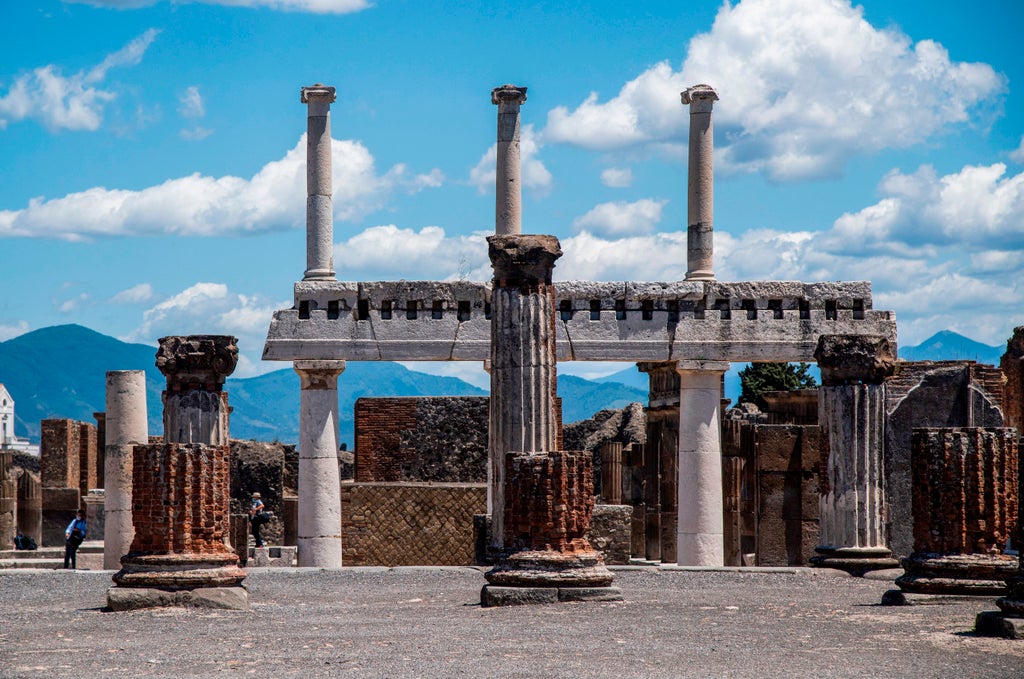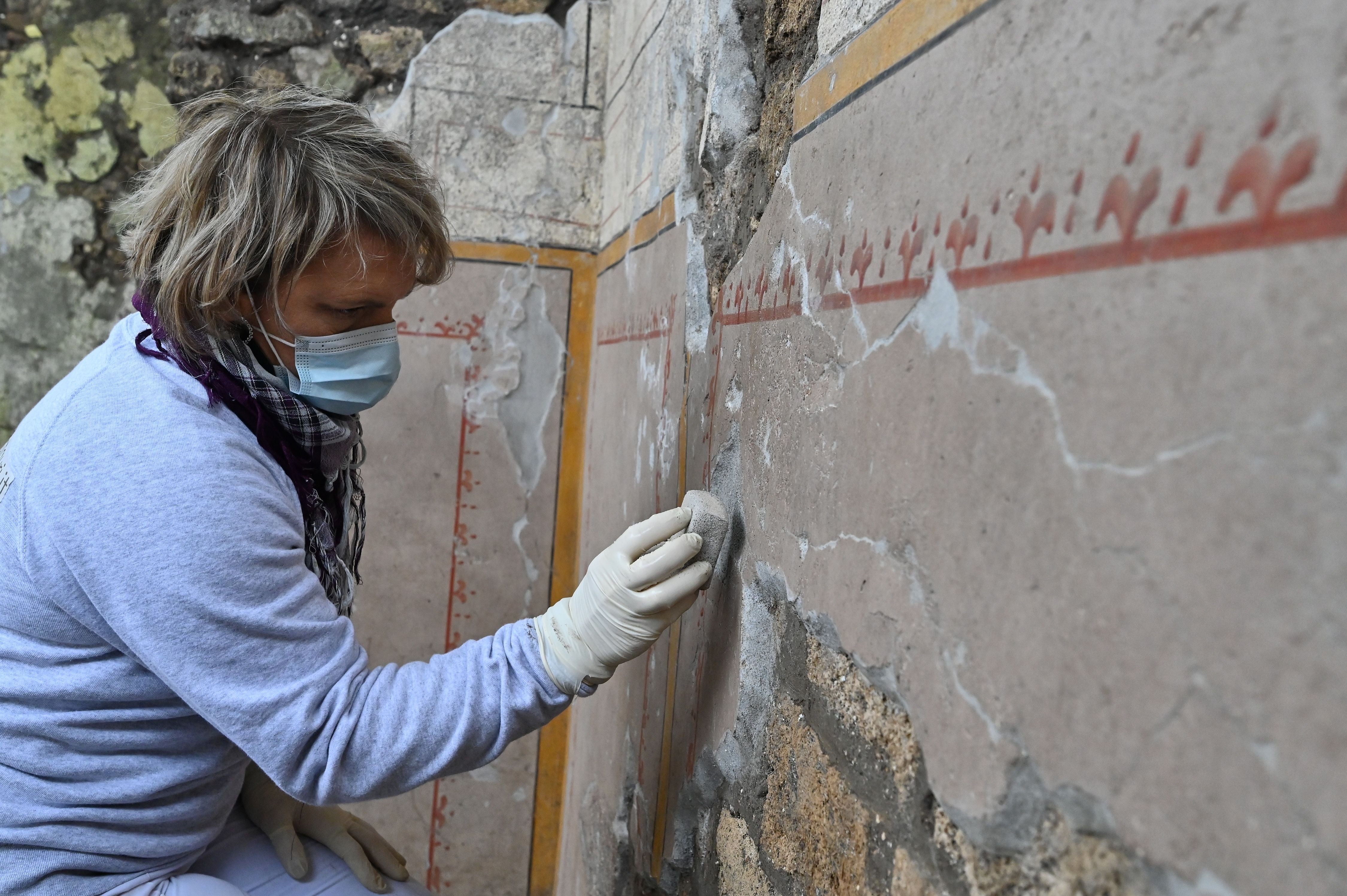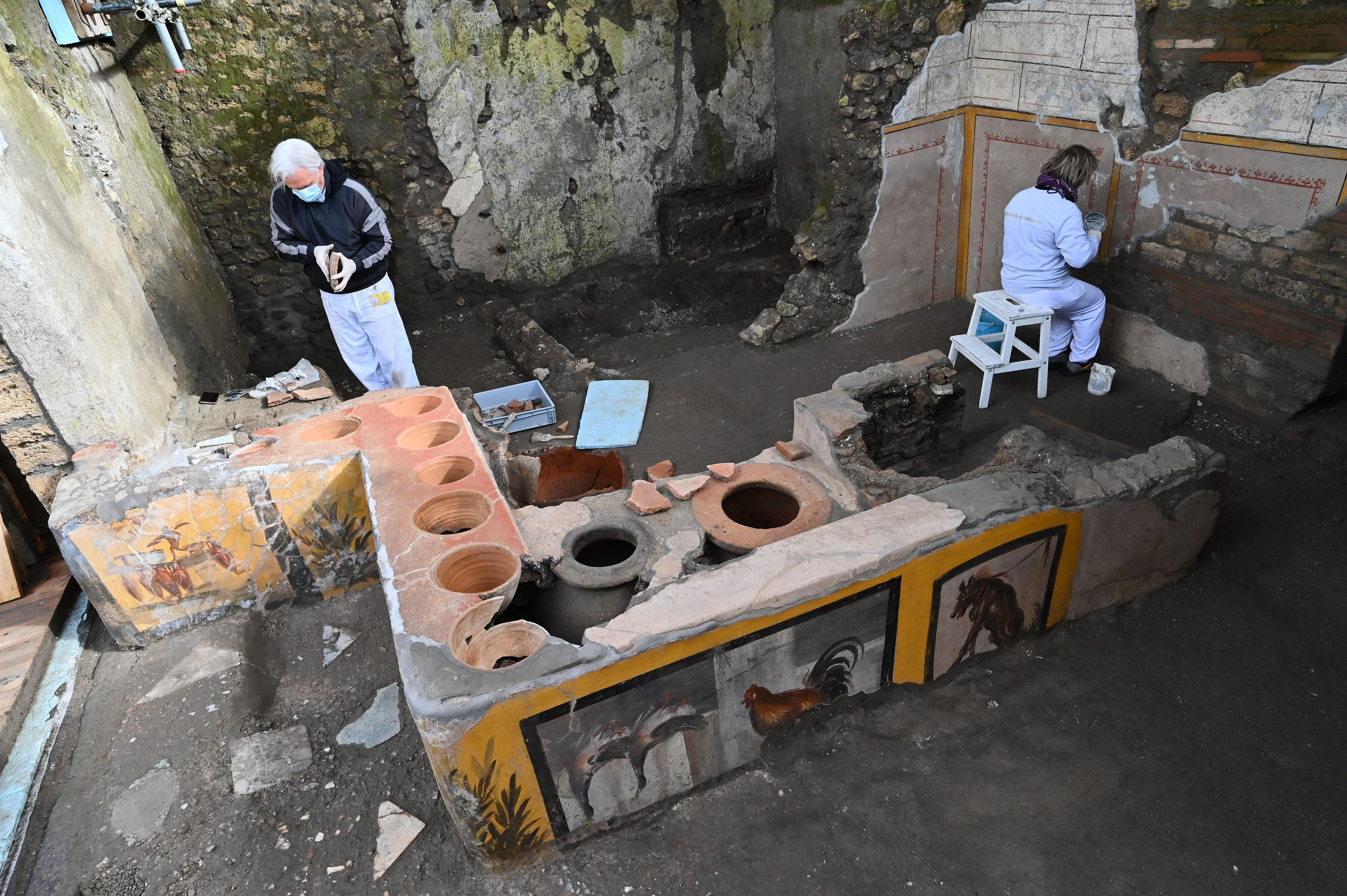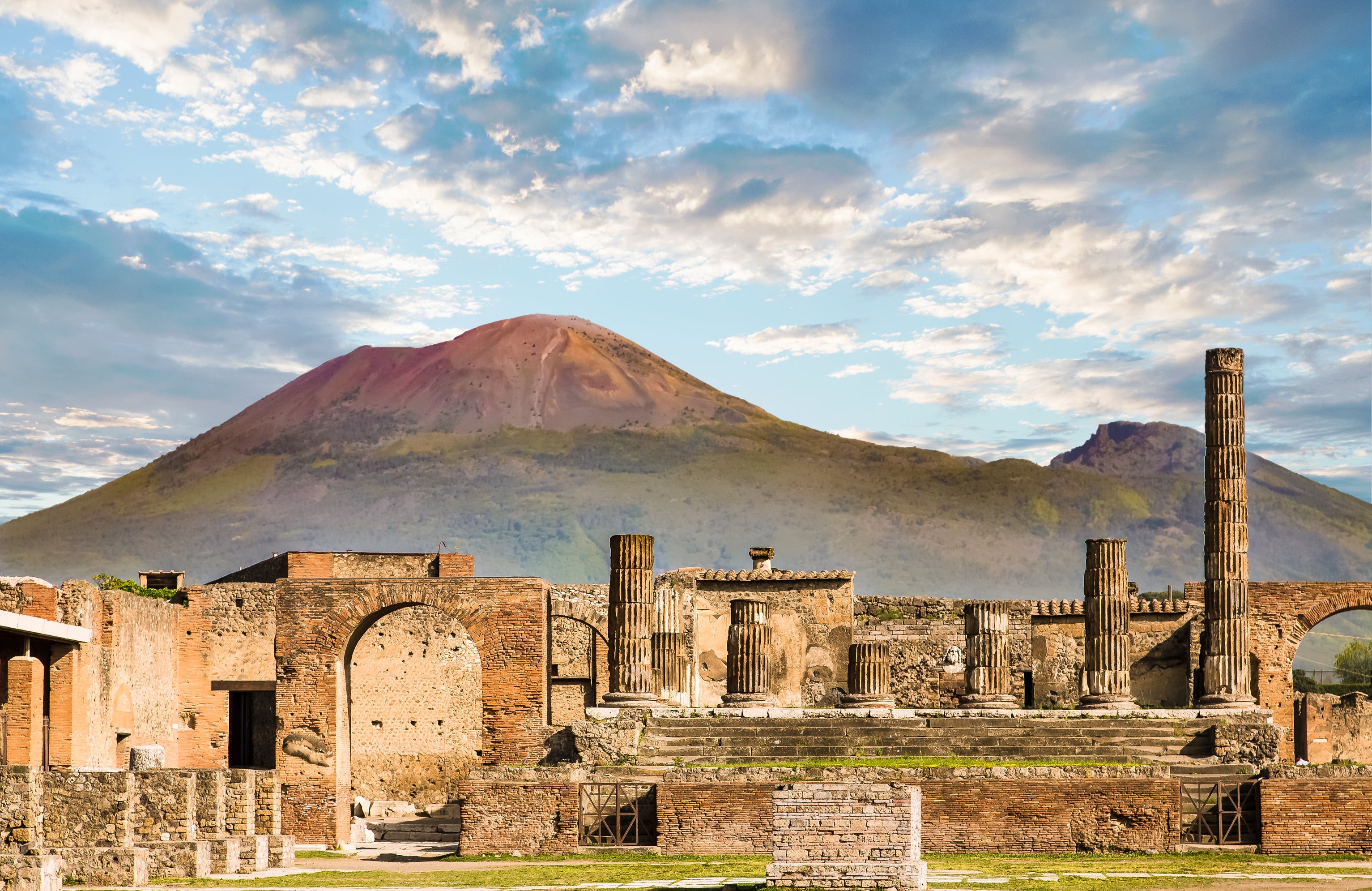
One morning at the necropolis of Porta Sarno, just outside Pompeii’s eastern edge, Mattia Buondonno gingerly raises a protective tarp covering a tomb discovered last year.
According to the inscription on the tomb’s pediment, its occupant was a freed slave named Marcus Venerius Secundio, who became rich and “organised performances in Greek and Latin that lasted four days,” Buondonno, a Pompeii tour guide, reads, translating from the Latin.
Inside the tomb, believed to date to just decades before the eruption of Mount Vesuvius that smothered Pompeii in AD79, archaeologists discovered one of the best preserved skeletons ever found. “It’s odd for that time. Normally adults were cremated,” Buondonno says.
But the tomb was important for other reasons, too.
“Recent finds like this show us new insight into the lower classes of Pompeii,” says Luana Toniolo, a former Pompeii staff archaeologist, who excavated the site. In particular, an epigraph with Secundio’s condensed biography — which also says he was a custodian at the Temple of Venus and trained for the priesthood in a cult — shed light on some occupations that freed slaves “could aspire to”, she says.
For archaeologists, the tomb inscription is also important as confirmation of a hitherto unverified theory that performances in Pompeii had been presented in Greek, the language most used in the eastern Mediterranean. It still isn’t clear whether those were musical or theatrical, but it is proof that Pompeii was a cosmopolitan city.
“We know people from throughout the Mediterranean lived in Pompeii,” Gabriel Zuchtriegel, 40, the site’s director, says in a video about the find. It was an open, multiethnic society, he adds.
It used to be that visitors thronged to the ancient ruins mostly to see dazzling frescoes in grandiose abodes, captivated by the tragedy of an ancient civilisation that had no chance of survival against the tons of ash, gas and rocks that snuffed out life in the city. But Zuchtriegel, the German-Italian archaeologist who took over Pompeii in 2021, is hoping that under his watch, visitors will get to know the ancient city through a broader lens, exploring its complex social stratification.
Sometimes you are suddenly very close to this reality of what probably the majority of inhabitants of Pompeii experienced
“Many of the questions we are today addressing are inspired by other fields emerging here, such as gender studies and post-colonial studies,” Zuchtriegel says. “We should not forget that all the wealth and art works that we see in Pompeii are really based on a society where not only slavery existed, but there was no concept of social welfare.”
Hard evidence of the grim life that enslaved people endured emerged last year with the discovery of “the Room of the Slaves” in a villa to the north of Pompeii. The cramped space contained three cots (the smallest one likely for a child), as well as a chamber pot and clay jugs, suggesting that its inhabitants were living in what was also a storage area. The room had been lit by a small upper window.
“Sometimes you are suddenly very close to this reality of what probably the majority of inhabitants of Pompeii experienced,” Zuchtriegel says. “I think it was a very tough society.”
There are plenty of items still to cross off on Zuchtriegel’s checklist to bring a site frozen in the first century into the 21st.
“We still need to think about how to better include people with disabilities, children, people with different cultural backgrounds,” he says. “It’s not just about the barrier-free access, it’s also about the language we use and the way we try to explain the site.”

For some, it is about time that these issues were finally out in the open. “Oftentimes archaeologists can be conservative with the topics they address,” Sarah E Bond, an associate professor of history at the University of Iowa, says in a phone interview, adding, “I am psyched to see things starting to come around in Pompeii.”
Increasingly, there has been a broader shift in scholarly research into the ancient world to investigate previously overlooked issues — “things like sexual assault and rape, or slavery,” Bond says. “It’s just great to now see Italian archaeologists overseeing Pompeii as a museum site, embracing important questions of gender, forced labour and violence in important ways.”
Among other headline-grabbing discoveries of recent years was a well-preserved thermopolium, or ancient snack bar, that shed light on ancient culinary tastes, which included a soupy concoction of snails, sheep and fish: “Pompeian street food,” Zuchtriegel quips.
In the so-called House With the Garden, not far from the thermopolium, a charcoal inscription found on one wall in the atrium would appear to date Vesuvius’s eruption to October rather than August, as has been traditionally held. “There were already many hints that the eruption was in the autumn: traces of pomegranates, fermenting wine, hearths in some rooms. You don’t light a fire in August,” says Nicola Meluziis, a Pompeii site employee.
Much of the work carried out in the past decade came under the aegis of the Great Pompeii Project. This $137m (£105m) effort, funded by the European Union, began in 2013 to better preserve the site, after a building collapsed in 2010, sparking international debate about the maintenance there.

“The money was spent, and spent well,” Zuchtriegel says, lavishing praise on his predecessor, Massimo Osanna, who oversaw the site when money was flowing, before he was promoted to oversee all of Italy’s museums. Osanna brought about “an enormous turnaround”, he says.
That also included an about-face in the way Pompeii communicated, says Bond, who gives Osanna credit for giving Pompeii a strong social media presence. During his tenure, Pompeii generated public interest by using Instagram and Twitter to announce discoveries, rather than keeping them under wraps until they were published in scholarly journals, the old way of doing things in Italy. “I saw a whole new generation of people engaging who had never been to the site of Pompeii, ever,” Bond says. “But they saw it on Instagram and they were just enthralled.”
Online presence aside, for Zuchtriegel, the real challenges to the site are on the ground, exacerbated by climate change, which he says has had a measurable impact: The site was now subject to abrupt temperature changes from hot to cold, and periods of drought, as well as very heavy rains. “All this adds stress to the ancient structures and frescoes, and it’s very concerning,” he says. “There is a reason why indoor museums normally have air-conditioning.”
New technology — including sensors, thermal imaging cameras and drones — are being introduced at Pompeii to provide data and images that immediately alert staff members to potential problems, like humidity in the walls or seismic activity.
“The goal is to have the real-time picture what’s actually happening,” so it would be possible to intervene before it’s too late, Zuchtriegel says.

Artificial intelligence and robotics are also being used to piece together the ceiling frescoes of the House of the Painters at Work, which was destroyed in a Second World War bombing. (That building, an ancient home, got its name because paint pots and brushes had been found in one room.) And 3D laser scanning technology was used to make a model of a horse skeleton unearthed in 1938 that recreated some of its missing parts.
New technologies will also play a role in explaining to visitors an area being restored on the western edge of the ancient site called “Insula Occidentalis”, which comprises several urban villas built on a slope overlooking the Gulf of Naples.
Paolo Mighetto, the architect who is overseeing the project, says brainstorming is underway on how best to bring the area alive for the public, perhaps by using holograms, or some sort of interactive illumination. “We’re thinking about different solutions,” he says. (There is already a Pompeii app that people can download on their smartphones and get information about buildings by scanning QR codes throughout the site.)
One villa in the area, the so-called House of the Library, offered up an especially interesting “treasure chest” of material, Mighetto says. It gives a sweeping sense of some 2,000 years’ worth of upheavals, including a major earthquake in AD 62; the eruption of Mount Vesuvius; Pompeii’s first excavation in the 18th century, when underground tunnels were dug beneath the building; and the deformations caused by Second World War bombs.
“We’re seeing traces of a succession of events over time,” says Mighetto. “Our challenge is to allow visitors to see the traces of these disastrous events through the lesions, cracks and deformations of the masonry,” he says, so that they could better “understand the drama of the past”, using these new technologies.
In a way, too, Pompeii has always been a trendsetting site: “Not only for archaeology, but for restoration techniques and for making archaeology accessible to the public,” Zuchtriegel says. “And that’s had a huge impact.”
This article originally appeared in The New York Times







